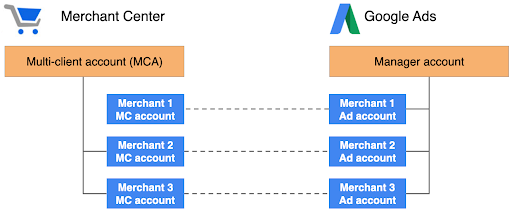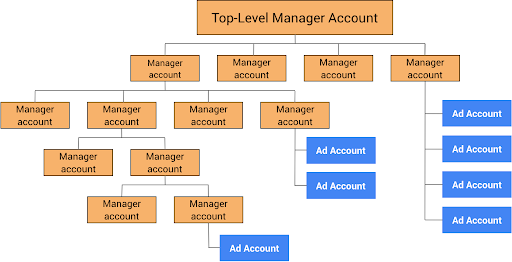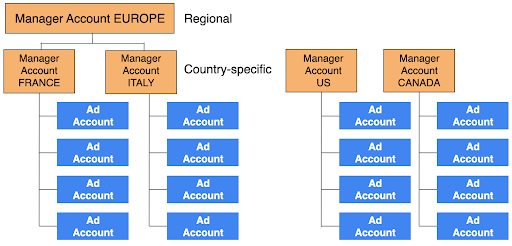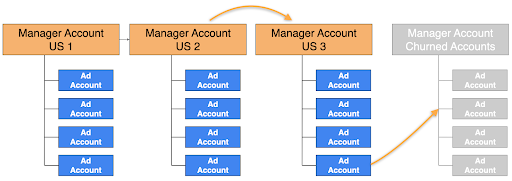4.0.3 设置 Google Ads 经理帐号
价值和业务影响
每个商家都需要一个单独的 Google Ads 广告客户帐号来投放效果最大化广告系列。要管理这些帐号,您需要创建 Google Ads 经理帐号。借助经理帐号,您可以为商家创建新帐号、管理多个帐号、设置跨帐号报告,以及设置合并结算。详细了解 Google Ads 经理帐号。
下图显示了每个商家的 Merchant Center 帐号如何与商家的 Google Ads 广告客户帐号相关联。

您还可以将多个 Google Ads 帐号与同一个 Merchant Center 帐号相关联,也可以将同一个 Google Ads 帐号与多个 Merchant Center 帐号相关联。
技术指南
如需创建经理帐号,请按照创建 Google Ads 经理帐号中的步骤操作。
将内部广告客户帐号(用于内部支出)保存在单独的经理帐号中,以及您代表客户管理的帐号。
请为您的帐号选择一个时区,以便进行帐号报告和结算。 此时区以后无法更改,请为您的组织选择时区。
为经理帐号选择一个固定不变的币种。此选项会将您的经理帐号与相应的币种相关联,以满足您帐号的任何特定结算需求。选择贵组织开展业务所用的币种。 您的客户的一个或多个帐号以其各自所选的币种进行结算。如需了解详情,请参阅经理帐号货币换算简介。
帐号结构和限制
如需查看所有限制的摘要,请参阅关于 Google Ads 帐号限制。
您可以创建带有子级经理帐号的顶级 Google Ads 经理帐号,每个子级经理帐号都管理多个 Google Ads 帐号,如下图所示。

请注意以下几点:
Google Ads 对每个顶级经理帐号的 Google Ads 帐号数量设有上限。如需了解详情,请参阅经理帐号的帐号数量上限简介。
经理帐号对您的 API 令牌可以访问的那组 Google Ads 帐号没有任何影响。
经理帐号的层级结构不能超过 6 层。
不同国家/地区的经理帐号
您应该设置经理帐号结构,以支持有关您业务的有意义的报告。下图展示了如何为不同国家/地区(例如法国、意大利、美国和加拿大)的商家组织经理帐号和广告客户帐号。

扩大帐号规模的最佳做法
如果您预计自己的商家需要超过 85,000 个 Google Ads 帐号,不妨考虑采用随着用户添加而扩展的帐号管理做法:
请在超出 85,000 个的上限之前,申请多个 Google Ads 经理帐号。将每个帐号添加到您的后端配置,并在创建新帐号时平衡每个经理帐号的 Google Ads 帐号数量。
随着时间的推移,已停止支出的广告客户(也称为“流失”帐号)会积累更多帐号。这些 ID 仍映射到其经理帐号,并计入帐号数量上限。我们建议您创建一个标记休眠帐号并将其移动到单独的经理帐号的流程。下图演示了这种可伸缩设计的示例。

